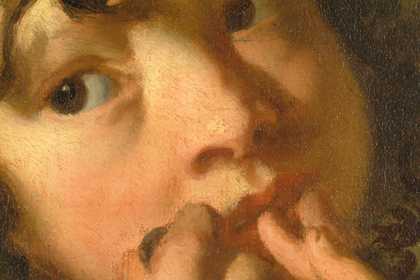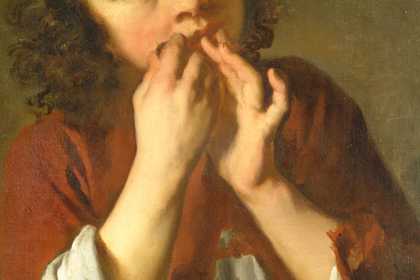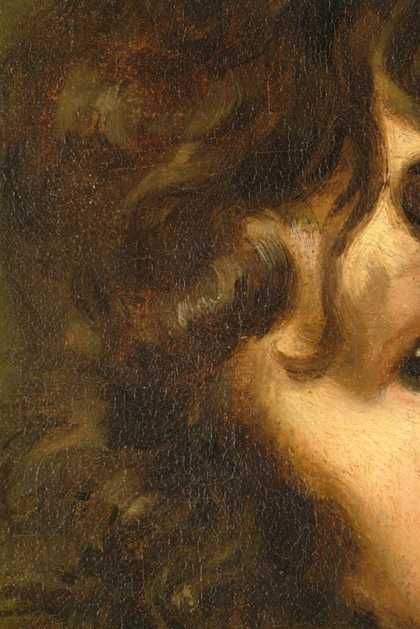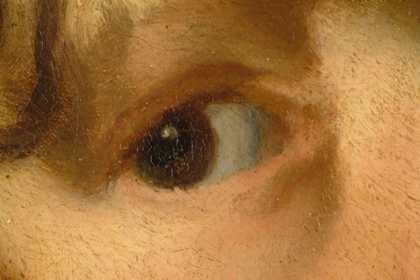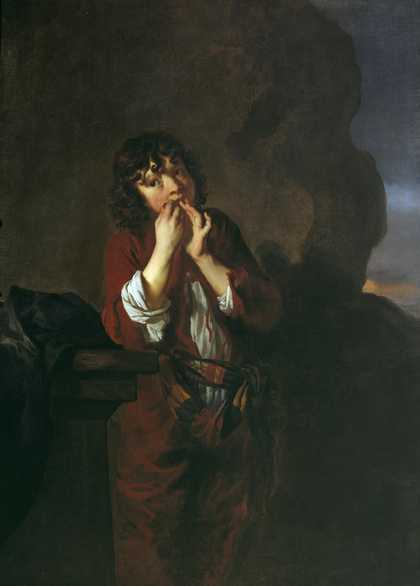
Fig.1
Sir Peter Lely 1618–1680
Boy Playing a Jew’s Harp
c.1648
Oil paint on canvas
1410 x 1029 mm
T00884
This painting is in oil paint on canvas measuring 1410 x 1029 mm (fig.1). The single piece of plain woven, linen canvas has an open weave with 12.5 threads per square cm in both directions. There are numerous weave faults and thickenings in the threads. There is strong cusping of the canvas weave on all sides but the original tacking margins are not present.1 In almost every respect this support is the same as the pendant to this painting, Man Playing a Pipe (Tate T00885). The present stretcher looks contemporary with the glue composition lining, which appears to date from the late nineteenth or early twentieth century, again as in the pendant painting. Unlike its pendant, however, this painting has an earlier glue lining canvas still intact between the original canvas and the visible lining canvas. As in the pendant painting, we have a good idea of the appearance of an earlier stretcher, which was probably the original. The X-radiograph shows the ghost of a narrow-barred stretcher or strainer with a horizontal cross-piece and diagonal braces at the inner corners (fig.2). A coat of paint must have been applied to the back of the painting after it had been attached to this stretcher, the brush able to reach behind most of the horizontal cross-piece but not under the outer bars or the diagonal braces. There is an inscription hand-written in pencil on the back of the present stretcher: ‘Left of Fireplace No.5’.
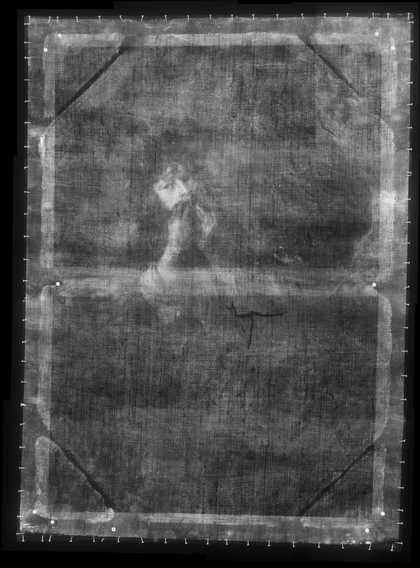
Fig.2
X-radiograph of Boy Playing a Jew’s Harp c.1648
The ground is a thin coat of buff coloured paint (figs.3–4). During application it was pressed deep into the canvas weave. Viewed in cross-section it appears as a semi-translucent, yellowish white layer on average 40 microns thick. It contains marine chalk, lead white and black.2 Tests with acid fuchsin on the ground of the pendant painting proved negative, indicating that its binding medium is oil.
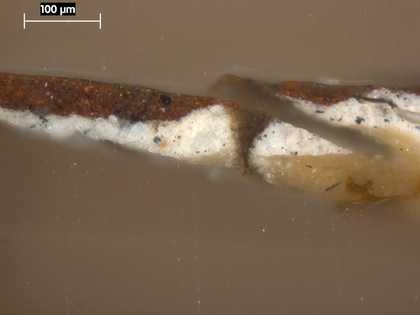
Fig.3
Cross-section through the dark red trousers at the bottom edge, photographed at x250 magnification. From the bottom: chalk ground; greyish beige priming; dark red paint
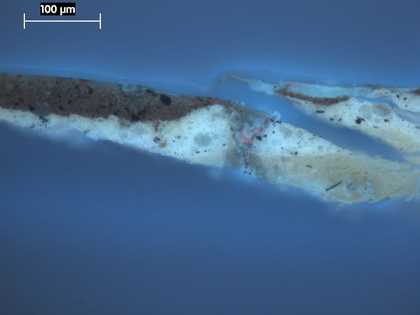
Fig.4
Cross-section through the dark red trousers at the bottom edge, photographed at x250 magnification in ultraviolet light. From the bottom: chalk ground; greyish beige priming; dark red paint. The pink line running down through the middle of the sample is the remains of the dye acid fuchsin, applied to indicate areas that might be bound in a proteinaceous medium; it has adhered itself only to the animal glue that has penetrated a crack in the painting, probably from a glue lining
The priming is opaque greyish beige colour, composed of lead white, chalk, Cologne earth, black and glassy particles, mixed together and bound in oil. It has a smooth surface but at about 65 microns average thickness, is thin enough to allow the texture of the weave to modulate it. Both these layers are present in the pendant painting.
Like most pictures by Lely in this study, this painting reveals no underdrawing with any method of examination. Using other, later works by Lely as evidence, it is probable that the image was laid in roughly with brown paint, which was often left to stand as the shadows of the figure in the finished painting, perhaps strengthened here and there with similarly coloured paint. The shadows of the flesh tones in this painting are mid-brown, so perhaps this was the colour used for the first lay-in (figs.5–10).
As in the pendant painting, the painted image was created almost entirely through masterly control of the brush and the choice of tones, rather than the modulation of opaque underpainting with bright colours and translucent glazes. Most of the painting was done in one layer, the opaque tones worked into one another wet-in-wet on the prepared canvas, for example in the face, hands and linen, or scumbled with stiff brushes in the background to modulate the thickness of the paint and allow the greyish beige ground to impart a sense of translucency in the thin areas (figs.11–13).
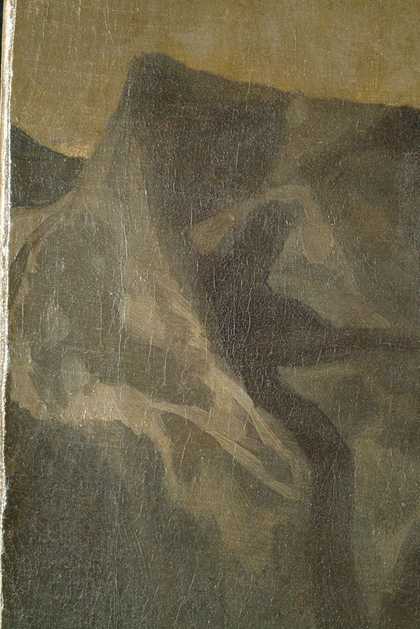
Fig.11
Detail of the drapery and background
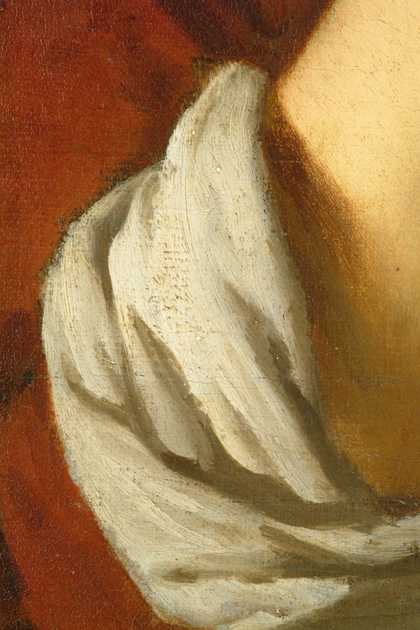
Fig.12
Detail of the brushwork in the sleeve
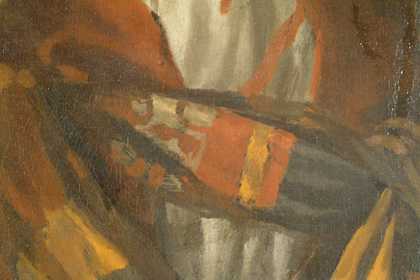
Fig.13
Detail of the brushwork in the costume
Very thin washy brushstrokes roughly describe the boy’s clothing down his left side and the ends of his sash; the highlights and shadows were strengthened with further applications of paint but even here a traditional technique of glazing opaque passages with translucent colour has been replaced by the admixture of translucent pigments into a largely opaque mixture (fig.14).
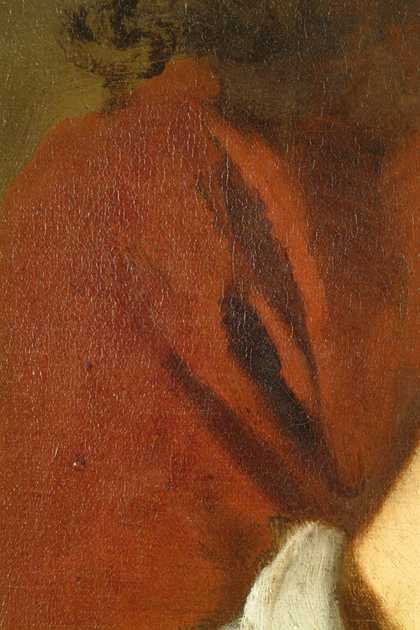
Fig.14
Detail of the drapery at the shoulder
The dark red, for example, is composed of large particles of translucent red lake and black in a dense matrix of opaque, finely ground reds, yellows and browns. Other colours were mixed from earth colours, vermilion, smalt, black, lead white and copious amounts of the warm brown, semi-translucent pigment, Cologne earth. Black underlayers are visible where overlying red paint has been abraded with time but it is possible that this designates a change of mind rather than preparatory underpainting. Pentimenti are visible in other areas of the clothing, for example the wide sweeping brushstroke in the sash at the waist (fig.15). Early cleaning has left some of the dark areas looking worn.3
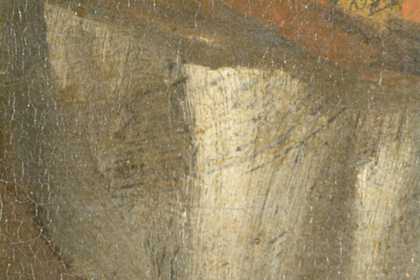
Fig.15
A pentimento in the drapery shows as a dark arc underneath the paint
The painting has needed no significant treatment since its acquisition by Tate in 1966.
July 2003

